Occupation Nun, poet, writer Role Poet Nationality Mexican Literary movement Baroque | Signature Siblings Josefa Maria de Asbaje Name Juana de | |
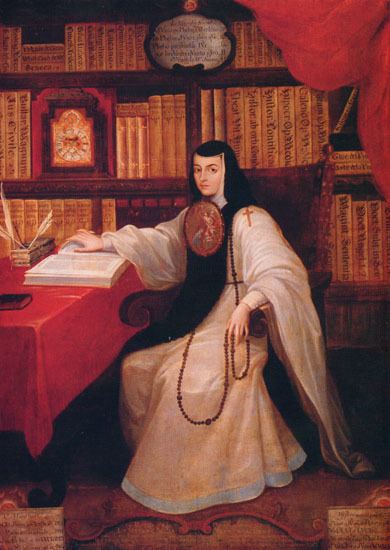 | ||
Relatives Pedro Manuel de Asbaje and Isabel Ramirez (parents) Died April 17, 1695, Mexico City, Mexico Parents Isabel Ramirez, Pedro Manuel de Asbaje Books Respuesta a sor Filotea de, A Sor Juana Anthology, Poems - protest - and a dre, Los empeños de una ca, A woman of genius Similar People Octavio Paz, Carlos de Siguenza y Gongora, Juan Ruiz de Alarcon, Luis de Gongora, Francisco de Quevedo | ||
Sor juana in s de la cruz poem casserley cielo
Sor Juana Inés de la Cruz, O.S.H. (English: Sister Joan Agnes of the Cross; 12 November 1651 – 17 April 1695), was a self-taught scholar, philosopher and poet of the Baroque school, and Hieronymite nun of New Spain, known in her lifetime as "The Tenth Muse", "The Phoenix of America", or the "Mexican Phoenix".
Contents
- Sor juana in s de la cruz poem casserley cielo
- Professor ana mar a hern ndez discussing her interest in sor juana in s de la cruz
- Life
- Life as a Nun
- The Dream
- Other notable works
- Studies of Juana Ins de la Cruz
- Historical memory and influence
- Official recognition by the Mexican government
- Inspiration and influence
- References
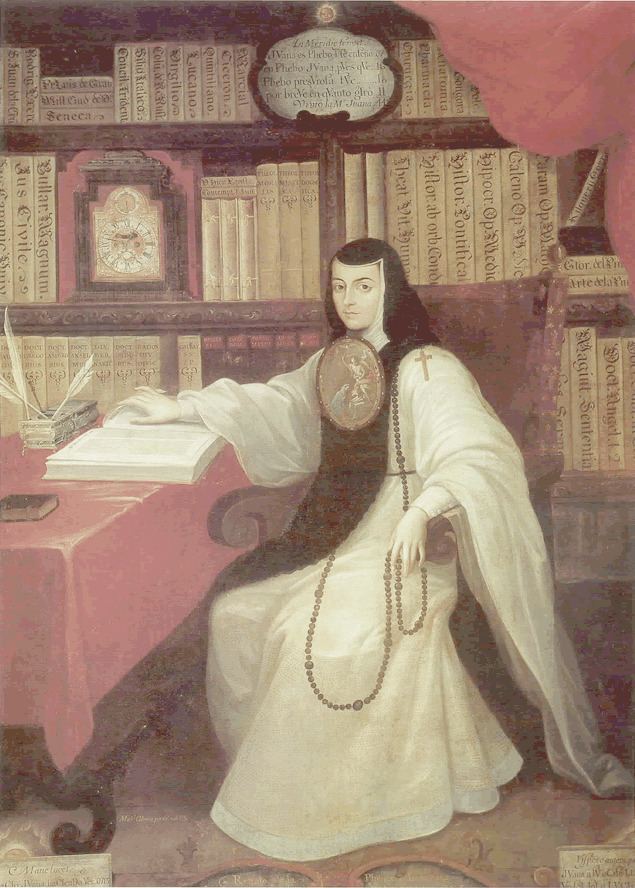
Sor Juana lived during Mexico's colonial period, making her a contributor both to early Mexican literature as well as to the broader literature of the Spanish Golden Age. Beginning her studies at a young age, Sor Juana was fluent in Latin and Nahuatl, and became known for her philosophy in her teens. After joining a nunnery in 1667, Sor Juana began writing poetry and prose dealing with such topics as love, feminism, and religion. Her criticism of misogyny and the hypocrisy of men led to her condemnation by the Bishop of Puebla, and in 1694 she was forced to sell her collection of books and focus on charity towards the poor. She died the next year, having caught the plague while treating her fellow nuns.
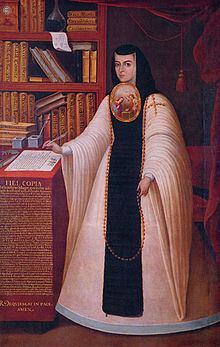
Professor ana mar a hern ndez discussing her interest in sor juana in s de la cruz
Life
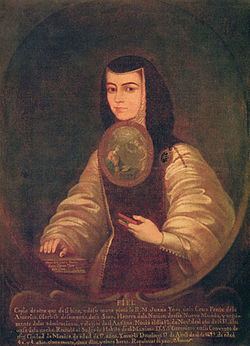
She was born Juana Inés de Asbaje y Ramírez de Santillana in San Miguel Nepantla (now called Nepantla de Sor Juana Inés de la Cruz in her honor) near Mexico City. She was the illegitimate child of a Spanish Captain, Pedro Manuel de Asbaje, and a Criolla woman, Isabel Ramírez. Her father, according to all accounts, was absent from her life. She was baptized 2 December 1651 and described on the baptismal rolls as "a daughter of the Church". She was raised in Amecameca, where her maternal grandfather owned an hacienda.
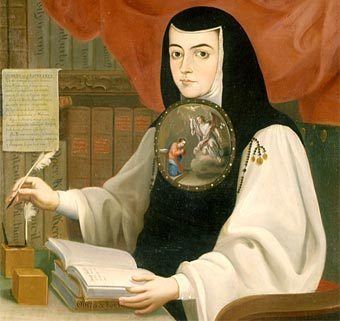
As a child, Juana often hid in the hacienda chapel to read her grandfather's books from the adjoining library, something forbidden to girls. She learned how to read and write Latin at the age of three. By age five, she reportedly could do accounts. At age eight, she composed a poem on the Eucharist.
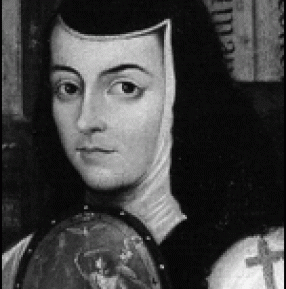
By adolescence, Juana had mastered Greek logic, and at age thirteen she was teaching Latin to young children. She also learned the Aztec language of Nahuatl, and wrote some short poems in that language.
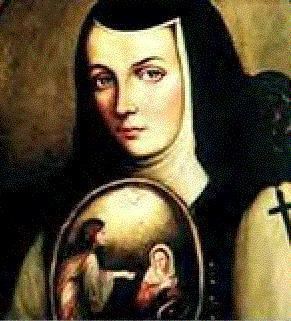
In 1664, at the age of 12, Juana was sent to live in Mexico City. She asked her mother's permission to disguise herself as a male student so that she could enter the university there. Not being allowed to do this, she continued her studies privately. She was a lady-in-waiting at the colonial viceroy's court, where she came under the tutelage of the Vicereine Leonor Carreto, wife of the Viceroy of New Spain Antonio Sebastián de Toledo. The viceroy (whom Appletons' Cyclopædia of American Biography names as the Marquis de Mancera), wishing to test the learning and intelligence of this 17-year-old, invited several theologians, jurists, philosophers, and poets to a meeting, during which she had to answer many questions unprepared and explain several difficult points on various scientific and literary subjects. The manner in which she acquitted herself astonished all present and greatly increased her reputation. Her literary accomplishments garnered her fame throughout New Spain. Her interest in scientific thought and experiment led to professional discussions with Isaac Newton. She was much admired in the viceregal court, and she received several proposals of marriage, which she declined.
Life as a Nun
In 1667, she entered the Monastery of St. Joseph, a community of the Discalced Carmelite nuns, as a postulant. She chose not to enter that order, which had strict rules. Later, in 1669, she entered the monastery of the Hieronymite nuns, which had more relaxed rules. She chose to become a nun so that she could study as she wished, saying she wanted "to have no fixed occupation which might curtail my freedom to study."
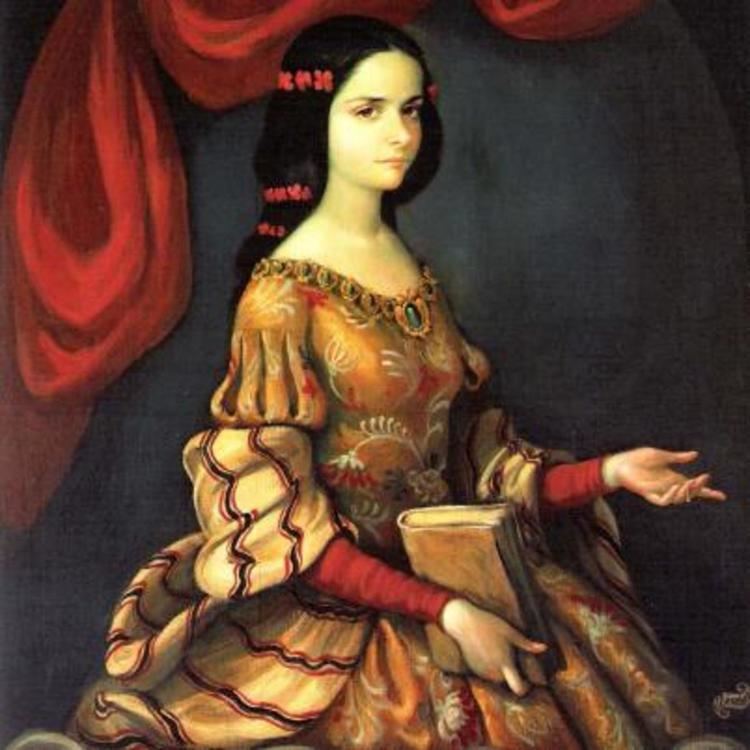
In the convent and perhaps earlier, Sor Juana became friends with fellow savant, Don Carlos de Sigüenza y Góngora, who visited her in the convent's locutorio. She stayed cloistered in the Convent of Santa Paula of the Hieronymite in Mexico City from 1669 until her death, and there she studied, wrote, and collected a large library of books. The Viceroy and Vicereine of New Spain became her patrons; they supported her and had her writings published in Spain.
One noted critic of her writing was the bishop of Puebla, Manuel Fernández de Santa Cruz, who in November of 1690 published Sor Juana's critique of a 40-year-old sermon by Father António Vieira, a Portuguese Jesuit preacher. In addition to publishing this without her permission (under the pseudonym of Sor Filotea), he told her to focus on religious instead of secular studies.
In response to critics of her writing, Juana wrote a letter, Respuesta a Sor Filotea de la Cruz (Reply to Sister Philotea), in which she defended women's right to education saying, "Oh, how much harm would be avoided in our country" if women were able to teach women in order to avoid the danger of male teachers in intimate setting with young female students. Sister Juana said that such hazards "would be eliminated if there were older women of learning, as Saint Paul desires, and instructions were passed down from one group to another, as in the case with needlework and other traditional activities." Sor Juana famously remarks, quoting an Aragonese poet and also echoing St. Teresa of Ávila: "One can perfectly well philosophize while cooking supper." In response, Francisco de Aguiar y Seijas, Archbishop of Mexico joined other high-ranking officials in condemning Sor Juana's "waywardness". By 1693, Sor Juana seemingly ceased writing rather than risk official censure. However, there is no undisputed evidence of her renouncing devotion to letters, though there are documents showing her agreeing to undergo penance. Her name is affixed to such a document in 1694, but given her deep natural lyricism, the tone of these supposed hand-written penitentials is in rhetorical and autocratic Church formulae; one is signed "Yo, la peor de todas" ("I, the worst of all women") She is said to have sold all her books, then an extensive library of over 4,000 volumes, and her musical and scientific instruments as well. Other sources report that her defiance toward the church led to all of her books and instruments being confiscated. Only a few of her writings have survived, which are known as the Complete Works. According to Octavio Paz, her writings were saved by the vicereine.
She died after ministering to other nuns stricken during a plague, on 17 April 1695. Sigüenza y Góngora delivered the eulogy at her funeral.
The Dream
The Dream, a long philosophical and descriptive silva (a poetic form combining verses of 7 and 11 syllables), "deals with the shadow of night beneath which a person falls asleep in the midst of quietness and silence, where night and day animals participate, either dozing or sleeping, all urged to silence and rest by Harpocrates. The person's body ceases its ordinary operations, which are described in physiological and symbolical terms, ending with the activity of the imagination as an image-reflecting apparatus: the Pharos. From this moment, her soul, in a dream, sees itself free at the summit of her own intellect; in other words, at the apex of an own pyramid-like mount, which aims at God and is luminous.
There, perched like an eagle, she contemplates the whole creation, but fails to comprehend such a sight in a single concept. Dazzled, the soul's intellect faces its own shipwreck, caused mainly by trying to understand the overwhelming abundance of the universe, until reason undertakes that enterprise, beginning with each individual creation, and processing them one by one, helped by the Aristotelic method of ten categories.
The soul cannot get beyond questioning herself about the traits and causes of a fountain and a flower, intimating perhaps that his method constitutes a useless effort, since it must take into account all the details, accidents, and mysteries of each being. By that time, the body has consumed all its nourishment, and it starts to move and wake up, soul and body are reunited. The poem ends with the Sun overcoming Night in a straightforward battle between luminous and dark armies, and with the poet's awakening."
Dramas
In addition to the two comedies outlined here (Pawns of a House [Los empeños de una casa] and Love is More a Labyrinth [Amor es mas laberinto]), Sor Juana is attributed as the author of a possible ending to the comedy by Agustin de Salazar: The Second Celestina (La Segunda Celestina). In the 1990’s, Guillermo Schmidhuber found a release of the comedy that contained a different ending than the otherwise known ending. He proposed that those one thousand words were written by Sor Juana. Some literary critics, such as Octavio Pas, Georgina Sabat-Rivers, and Luis Leal) have accepted Sor Juana as the co-author, but others, such as Antonio Alatorre and Jose Pascual Buxo, have refuted it.
Pawns of a House
The work was first performed on October 4, 1683, during the celebration of the Viceroy Count of Paredes’ first son’s birth. However, some critics maintain that it could have been set up for the Archbishop Francisco de Aguiar y Seijas’ entrance to the capital, even though this theory is not considered reliable.
The story revolves around two couples who are in love but, by chance of fate, cannot yet be together. This comedy of errors is considered one of the most prominent works of late baroque Spanish-American literature. One of its most peculiar characteristics is that the driving force in the story is a woman with a strong, decided personality who expresses her desires to a nun. The protagonist of the story, Dona Leonor, fits the archetype perfectly.
It is often considered the peak of Sor Juana’s work and even the peak of all New-Hispanic literature. Pawns of a House is considered a rare work in colonial Spanish-American theater due to the management of intrigue, representation of the complicated system of marital relationships, and the changes in urban life.
Love is More a Labyrinth
The work premiered on February 11, 1689, during the celebration of the inauguration of the viceroyalty Gaspar de la Cerda y Mendoza. However, in his Essay on Psychology, Ezequiel A. Chavez mentions Fernandez del Castillo as a coauthor of this comedy.
The plot takes on the well-known theme in Greek mythology of Theseus: a hero from Crete Island. He fights against the Minotaur and awakens the love of Ariadne and Fedra. Sor Juana conceived Theseus as the archetype of the baroque hero, a model also used by her fellow countryman Juan Ruis de Alarcon. Theseus’ triumph over the Minotaur does not make Theseus proud, but instead allows him to be humble.
Other notable works
Studies of Juana Inés de la Cruz
There is a vast scholarly literature on Sor Juana in Spanish, English, French, and German.
Her works have appeared in translation. An early translation of Sor Juana's work into English was Ten Sonnets from Sor Juana Inez de la Cruz [sic], 1651-1695: Mexico's Tenth Muse, published in Taxco, Guerrero, in 1943. The translator was Elizabeth Prall Anderson who settled in Taxco. One musical work attributed to Sor Juana survives from the archive at Guatemala Cathedral. This is a 4-part villancico, Madre, la de los primores.
An important translation to English of a work by Juana Inés de la Cruz for a wide readership is published as Poems, Protest, and a Dream in a 1997 Penguin Classics paperback, which includes her response to authorities censuring her.
Arguably the most important book devoted to Sor Juana, written by Nobel Prize laureate Octavio Paz in Spanish and translated to English in 1989 as Sor Juana: Or, the Traps of Faith (translated by Margaret Sayers Peden). This work examines and contemplates Sor Juana's poetry and life in the context of the history of New Spain, particularly focusing on the difficulties women then faced while trying to thrive in academic and artistic fields. Paz describes how he had been drawn to her work by the enigmas of Sor Juana's personality and life paths. "Why did she become a nun? How could she renounce her lifelong passion for writing and learning?"
In his book, Paz makes a thorough analysis of Sor Juana's poetry and traces some of her influences to the Spanish writers of the Golden Age and the Hermetic tradition, mainly derived from the works of a noted Jesuit scholar of her era, Athanasius Kircher. Paz analyses Sor Juana's most ambitious and extensive poem, "First Dream" ("Primero Sueño") as largely a representation of the desire of knowledge through a number of hermetic symbols, albeit transformed in her own language and skilled image-making abilities. In conclusion, Paz makes the case that Sor Juana's works were the most important body of poetic work produced in the Americas until the arrival of 19th-century figures such as Emily Dickinson and Walt Whitman.
Tarsicio Herrera Zapién, a classical scholar, has devoted much of his career to the study of Sor Juana's works. Some of his publications (in Spanish) include Buena fe y humanismo en Sor Juana: diálogos y ensayos: las obras latinas: los sorjuanistas recientes (1984); López Velarde y sor Juana, feministas opuestos: y cuatro ensayos sobre Horacio y Virgilio en México (1984); Poemas mexicanos universales: de Sor Juana a López Velarde (1989) and Tres siglos y cien vidas de Sor Juana (1995).
Historical memory and influence
Sor Juana was a famous and controversial figure in the seventeenth century. In the modern era, she has been honored in Mexico as well as being the part of a political controversy in the late twentieth century. During renovations at the cloister in the 1970s, bones were found that are believed to be those of Sor Juana. Also found at the same time was a medallion similar to the one depicted in portraits of Sor Juana. The medallion was kept by Margarita López Portillo, the sister of President José López Portillo (1976-1982). During the tercentennial of Sor Juana's death in 1995, a member of the Mexican congress called on Margarita López Portillo to return the medallion, which she said she had taken for "safekeeping." She returned it to Congress on November 14, 1995, with the event and description of the controversy reported in the New York Times a month later. Whether or not the medallion is Sor Juana's, the incident sparked discussions about Sor Juana and abuse of official power in Mexico.
Official recognition by the Mexican government
She was honored by the Mexican government in significant ways.
Inspiration and influence
Sor Juana has been the inspiration for film makers and authors of poetry, plays, opera, and literary fiction.
